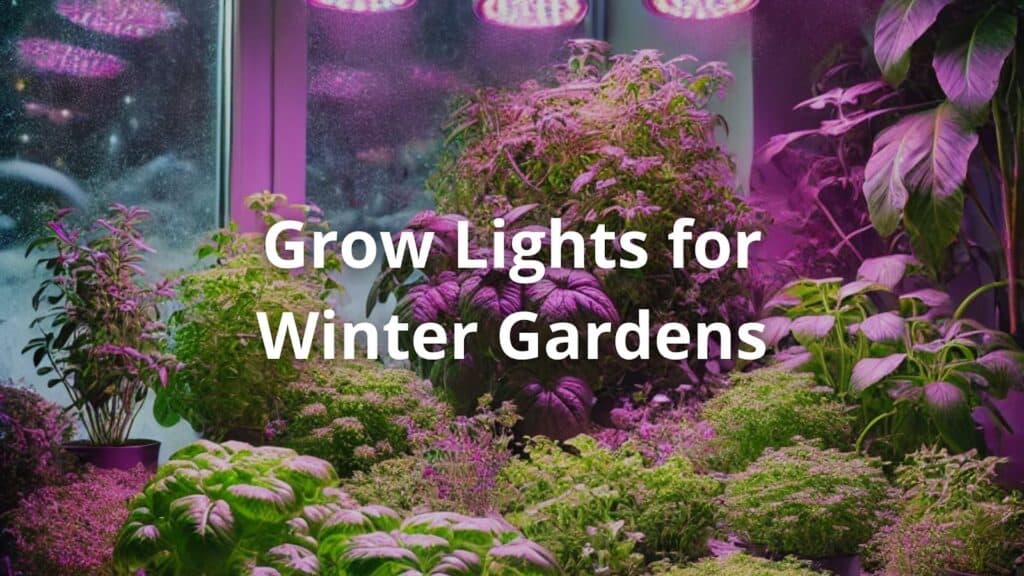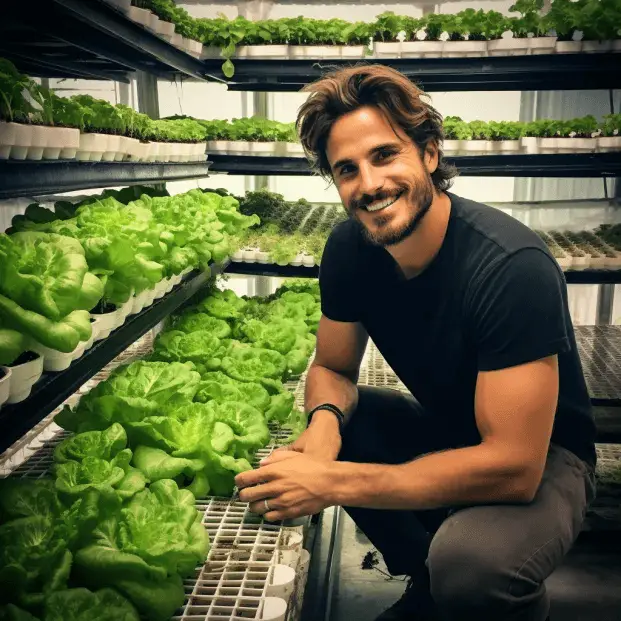As the crisp winter chill creeps in, I often find myself gazing out my window at the gray skies and bare trees, longing for the vibrant greens of summer. It’s a tough time for plants, especially houseplants that need a good dose of light to stay healthy and happy.
That’s where grow lights come in. These nifty devices can transform your winter garden into a thriving paradise, even when natural sunlight is scarce. Keep reading to find out how to use grow lights for your indoor gardening dreams.
Key Takeaway
- Grow lights provide a consistent light source essential for plant growth during winter.
- Full-spectrum LED grow lights mimic natural sunlight, helping plants thrive indoors.
- Proper placement and timing of grow lights can make a big difference in your plants’ health.
Why Use Grow Lights for Winter gardens?

Winter brings shorter days. Plants can struggle. They need light to grow strong. Without enough sunlight, they can become leggy. A basil plant might look sad and weak. Grow lights can help. These lights act like sunshine for plants. They help plants make energy through photosynthesis.
Grow lights come in different types. Some are LED, and some are fluorescent. LED lights last longer and use less energy. They might save money too. A good grow light should have a light spectrum that resembles sunlight. This helps plants grow better.
For indoor gardening, keep the lights about 12 to 24 inches above the plants. This distance helps avoid burning the leaves.
Plants need about 12 to 16 hours of light a day. Using grow lights can be a game changer for keeping plants healthy in winter. So, don’t let your plants struggle; give them the light they need!
Benefits of Grow Lights
- Plants need light to grow strong. A consistent light source from grow lights is key. With these lights, plants receive a steady beam of light. This is super important for photosynthesis, the process that helps plants make their food. Without enough light, plants can struggle and grow weak.
- Grow lights also extend the growing season. Even in the cold months, favorite vegetables and herbs can thrive. It means fresh salads and tasty dishes are just a flick of a switch away!
- Full-spectrum LED grow lights are a great choice. They mimic the sunlight that plants love. This means plants can get all the good stuff they need to thrive. Better growth leads to healthier plants.
Using grow lights can make a big difference. They help plants flourish, even in winter (1). So, for anyone wanting to grow indoors, grow lights can be a simple solution!
What Plants Love Grow Lights?

Not every plant loves grow lights, but many really enjoy them! For plants that crave lots of light, grow lights are a must-have. Here’s a list of plants that will thrive with a little help from grow lights:
- Succulents: These little guys need a ton of light to stay perky. Without enough, they can get leggy and sad.
- Leafy Greens: Lettuce, spinach, kale, and Swiss chard will all love the boost in light. They grow better and taste fresher with extra sunshine.
- Herbs: Basil, cilantro, parsley, and mint are great choices for indoor gardening. They’ll flourish under grow lights, giving off lovely scents and flavors.
- Fruiting Plants: Tomatoes and brinjals (that’s another name for eggplants) need lots of light to grow juicy fruits. With the right light, these plants can produce delicious harvests.
Using grow lights can help these plants reach their full potential. So, if someone has a green thumb and loves indoor gardening, these plants will definitely appreciate the extra light!
Types of Grow Lights
Credits: Epic Gardening
When it comes to grow lights, there are a few types to choose from, but LED grow lights are often the best for indoor gardens (2). Here’s a quick rundown of what’s available:
- LED Grow Lights: These lights are energy-efficient and produce less heat. This means they keep plants cozy without burning them. Plus, they help plants grow faster!
- SANSI LEDs: These are full-spectrum lights that mimic natural light. They provide great growth and healthy plants. The best part? They don’t have that annoying purple tint that makes it hard to see how plants are doing.
- Other Options: There are also LED plant lamps, fluorescent tubes, and daylight lamps. Some people even use sodium and metal halide lamps. But they can be pricier and not as energy-efficient as LEDs.
Choosing the right type of grow light can make a big difference in how well indoor plants thrive. So, for anyone looking to brighten their indoor garden, LED lights are a smart choice!
How to Use Grow Lights
Using grow lights isn’t just about turning them on and forgetting about them. There are a few things to keep in mind to help your plants get the most out of their new light source.
Light Spectrum
Plants need different colors of light for different reasons. Blue light is super important because it helps them grow taller and develop stronger leaves. It’s like giving them a boost to reach up for more light!
On the other hand, red light plays a key role in blooming and fruiting. When plants get enough red light, they can produce beautiful flowers and tasty fruits.
So, it’s important to have a mix of blue and red light. This combination helps plants grow healthy and strong throughout their life cycle.
Using grow lights that provide both colors can make a big difference in how well plants thrive. It’s all about giving them the right kind of light they need to flourish!
Duration
Most plants do well with about 12 to 16 hours of light each day (3). This amount of light helps them grow strong and healthy. It’s like a daily routine for them!
Using timers can be a great idea. Timers help make sure plants get just the right amount of light without waking them up too early. This way, plants can enjoy their beauty sleep, just like anyone else!
Setting a timer can help create a consistent schedule. This is important for plants because they thrive on routine. With a little planning, anyone can help their indoor garden flourish with the perfect light. It’s a simple trick that can lead to happy and healthy plants!
Distance
Positioning your grow light is important, too. Keeping it about 12 to 18 inches above your plants is a smart move. This distance allows plants to soak in all that goodness without getting burned.
If the light is too close, it can cause the leaves to fry. And nobody wants that! By placing the light at the right height, plants can enjoy the benefits of bright light while staying safe.
It’s all about finding that sweet spot. With the right positioning, plants can thrive and grow big and strong. So, take a moment to adjust those lights for the best results!
Color Temperature
When choosing LED grow lights, look for a color temperature around 6500K. This mimics natural daylight, making plants feel like they’re outdoors.
Having lights that closely resemble sunlight helps plants grow better. They can photosynthesize effectively and thrive just like they would in a sunny garden.
Using lights with the right color temperature can make a big difference. It’s like bringing the outdoors inside! So, for anyone wanting happy and healthy plants, keeping an eye on color temperature is key.
Additional Tips for Happy Plants
Just because there are grow lights doesn’t mean plants can be forgotten. Here are some extra tips to help them thrive:
- Watering: Plants need less water in winter. It’s a good idea to let the top inch of soil dry out before watering. Too much water can lead to root rot, which is not good at all!
- Humidity: Winter air can be dry, and that isn’t great for plants. To bump up humidity, place a tray of water and pebbles near your plants or group them together. They’ll appreciate the extra moisture!
- Well-draining Soil: Make sure plants are in soil that drains well. Compacted soil can suffocate roots and keep them from getting the air they need.
Following these tips can help indoor plants stay happy and healthy, even in the colder months. A little care goes a long way!
FAQ
What do I need to start indoor gardening and how much space do I really need?
Indoor gardening can fit any space, from a small windowsill to a dedicated grow room. You’ll need basic containers, soil, grow lights if natural sunlight is limited, and proper ventilation. Urban gardening is perfect for apartments, and vertical gardening can maximize limited space.
How do grow lights work and which type should I choose for my indoor plants?
LED grow lights and high-pressure sodium lamps are popular choices. LED grow lights are energy efficient with lower heat output. Full-spectrum lights support all growing stages, from seedling to flowering stage. Consider the light intensity and light distance needed for your specific plants.
How do I manage light cycles for different plant growth stages?
Plants need different light cycles during vegetative growth versus the flowering stage. Use a timer to maintain consistent light duration. The photosynthetically active radiation (PAR) needs vary – seedlings typically need less intense light than flowering plants.
What are the essential elements of plant care for indoor gardening success?
Focus on plant health through proper pest control and disease prevention. Monitor humidity and temperature control while ensuring good ventilation. Regular plant care includes checking nutrient solution levels if using hydroponics, or maintaining organic gardening practices in soil.
Conclusion
As winter descends, grow lights can be a gardener’s best friend, brightening up indoor spaces and keeping plants healthy and vibrant. With the right type of light and care, you can enjoy fresh herbs and vibrant greens throughout the cold months. So, don’t be afraid to bring a little sunshine indoors and watch your winter garden flourish!
References
- https://www.sciencedirect.com/science/article/pii/S2468014121000881
- https://www.thermoline.com.au/blog/led-lighting-in-plant-growth-research
- https://www.geturbanleaf.com/blogs/lighting/how-long-you-should-leave-grow-lights-on
Related Articles
- https://tophydroponicgarden.com/grow-lights/
- https://tophydroponicgarden.com/led-vs-fluorescent-grow-lights/
- https://tophydroponicgarden.com/hydroponic-supplies/
- https://tophydroponicgarden.com/how-to-increase-light-intensity-for-hydroponic-systems/
Was this helpful?

I’m Barrie L., a passionate hydroponic gardening enthusiast dedicated to cultivating thriving, soil-less gardens. With a focus on all things hydroponic, I share my expertise on innovative growing techniques and sustainable practices through my blog, tophydroponicgarden.com. As a seasoned hydroponics specialist, my goal is to inspire and guide fellow gardeners in harnessing the power of water-based cultivation for bountiful and eco-friendly harvests. I’m also an author of the book “Hydroponics For Absolute Beginners: Your Step By Step Guide For How To Create An Hydroponics System At Home Without Soil, For Growing Vegetable, Fruit And Herbs.” which is sold on Amazon. Join me on a journey of redefining the way we cultivate plants, one nutrient-rich solution at a time. Happy growing!


